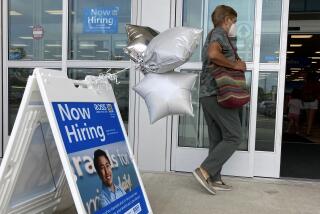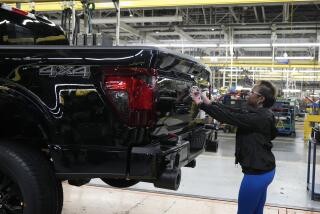U.S. economy to grow at solid rate but labor market to recover slowly
WASHINGTON — The U.S. economy should grow at a solid rate over the next few years, but the labor market will continue to recover only slowly, according to new projections by the Congressional Budget Office.
In its latest budget and economic outlook, the CBO on Tuesday forecast that economic growth will rise to 3.1% this year, boosted by gains in housing construction and business investment. And growth in economic output is projected to speed up to 3.4% in each of the next two years.
Those rates are well ahead of last year’s pace of 1.9%, the government’s most recent estimate.
But the nonpartisan agency was much less sanguine about U.S. economic expansion in the long term, partly because the aging population will contribute to slower labor force growth.
The report also noted that the Affordable Care Act, President Obama’s healthcare law, will result in many people reducing their work hours because of the availability of insurance subsidies.
The CBO foresees only modest job growth ahead and the unemployment rate to end this year at about the same 6.7% rate where it was in December. And from there, the jobless figure will decline only gradually, not falling below 6% until 2017, it said.
One key factor in the slow decline in the jobless rate is an expected return to the labor market of many unemployed people who had quit looking for work in recent years.
Because the unemployment figure measures only those unemployed who are actively searching for jobs, the current rate masks the actual number of available workers in the economy.
As the economy keeps expanding and many of these unemployed people reenter the labor market, they will put upward pressure on the jobless rate.
The unemployment rate could drop faster if economic output accelerates and there’s greater demand for goods and services, prompting employers to add more workers. In fact, the CBO said that without such cyclical weakness in sales and production, the jobless rate would be one percentage point lower, or 5.7%.
But the CBO also believes that structural problems in the labor market are accounting for another one-percentage-point elevation in the current unemployment rate.
The CBO sees these problems as primarily twofold: the unusually large number of long-term unemployed who face a stigma in the job market, and difficulties that employers are having filling vacancies partly because of a lack of skilled workers, especially in manufacturing and high-tech firms.
“The slow growth of the economy has been the most important determinant of the path of the unemployment rate in the years since the onset of the recession, but structural factors have played a notable role as well — and one that has become relatively more significant as the economy has improved,” the CBO said in a companion report on the labor market.
“By the end of 2013, the causes of the roughly two-percentage-point net increase in the rate of unemployment since the end of 2007 were identified as having been almost equally cyclical and structural, in CBO’s assessment,” the agency said.
“If the unemployment rate was back down to its pre-recession level of roughly 5%,” it said, “about 3 million people who are currently looking for work would be employed.”
More to Read
Inside the business of entertainment
The Wide Shot brings you news, analysis and insights on everything from streaming wars to production — and what it all means for the future.
You may occasionally receive promotional content from the Los Angeles Times.











